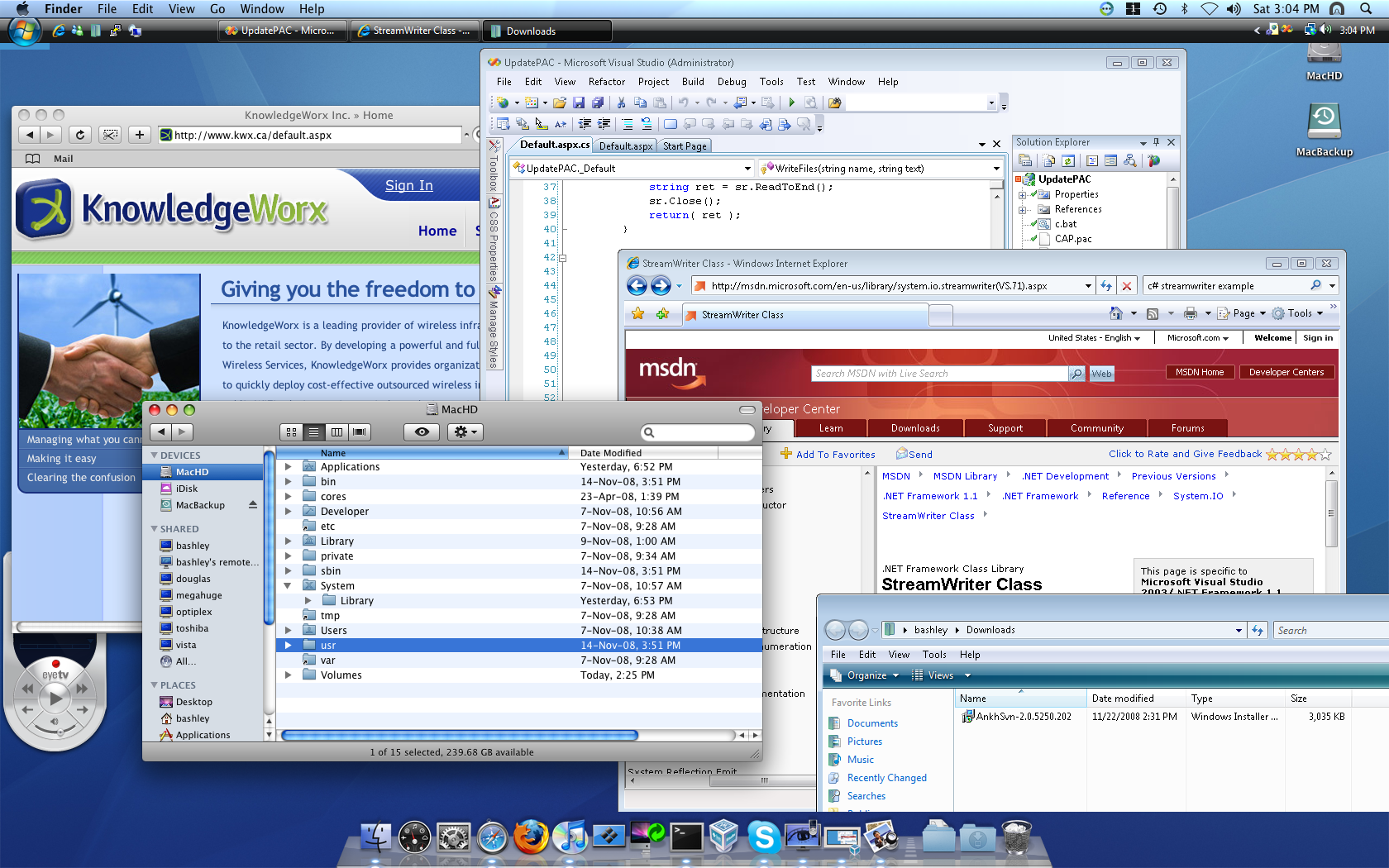
Seamless Visual Studio on the Mac with VirtualBox
Saturday, November 22nd, 2008
A few stars aligned recently and the result is fascinating.
1) I got myself 2G memory, a 320G disk and a 20″ display (and a putty knife!) and upgraded my Mac Mini. Then I upgraded to Leopard and hooked up the old drive in an external USB enclosure as a Time Machine drive.
2) I got a promotional copy of Visual Studio 8 from Microsoft. I’ve been using Visual Studio 2005 and wanted to give 2008 a spin, and with Joey as a new MS evangelist, the timing was right.
3) I subscribed to Technet Plus, which gives me evaluation copies of Vista and XP, among other things.
4) I installed Sun’s VirtualBox on my Mac, with its Seamless Mode feature that’s available when you have the Guest Additions loaded onto the virtual machine.
Sooo, I loaded up Vista Ultimate in a VM with Visual Studio, TortoiseSVN and the AnhkSVN plugin for VS2008, set up the IPSEC and OpenVPN connections to my office, and loaded up some code.
I now ready to do some serious evaluating in a killer hybrid environment, as you can see by the picture. Where to start?!
VirtualBox’s Seamless mode means that I can essentially run a Mac and a Windows PC simultaneously. For someone like me who uses both environments, it’s a nerdy dream. I could even throw in a Linux VM if I wanted to confuse myself further.
I’m also trying something similar with my Acer Aspire One. I have it running Ubuntu as its main OS on the 8G SSD. On the 8G SDHC card, I have a VirtualBox-powered XPPRO VM and I’m running it seamlessly with Ubuntu. With one toolbar on the top and the other on the bottom, it’s quite useful, especially when used in conjunction with an external monitor, but still workable in 1024×600:
The best part is that both of these setups perform very well on modest machines.
A few stars aligned recently and the result is fascinating.
1) I got myself 2G memory, a 320G disk and a 20″ display (and a putty knife!) and upgraded my Mac Mini. Then I upgraded to Leopard and hooked up the old drive in an external USB enclosure as a Time Machine drive.
2) I got a promotional copy of Visual Studio 8 from Microsoft. I’ve been using Visual Studio 2005 and wanted to give 2008 a spin, and with Joey as a new MS evangelist, the timing was right.
3) I subscribed to Technet Plus, which gives me evaluation copies of Vista and XP, among other things.
4) I installed Sun’s VirtualBox on my Mac, with its Seamless Mode feature that’s available when you have the Guest Additions loaded onto the virtual machine.
Sooo, I loaded up Vista Ultimate in a VM with Visual Studio, TortoiseSVN and the AnhkSVN plugin for VS2008, set up the IPSEC and OpenVPN connections to my office, and loaded up some code.
I now ready to do some serious evaluating in a killer hybrid environment, as you can see by the picture. Where to start?!
VirtualBox’s Seamless mode means that I can essentially run a Mac and a Windows PC simultaneously. For someone like me who uses both environments, it’s a nerdy dream. I could even throw in a Linux VM if I wanted to confuse myself further.
I’m also trying something similar with my Acer Aspire One. I have it running Ubuntu as its main OS on the 8G SSD. On the 8G SDHC card, I have a VirtualBox-powered XPPRO VM and I’m running it seamlessly with Ubuntu. With one toolbar on the top and the other on the bottom, it’s quite useful, especially when used in conjunction with an external monitor, but still workable in 1024×600:
The best part is that both of these setups perform very well on modest machines.




